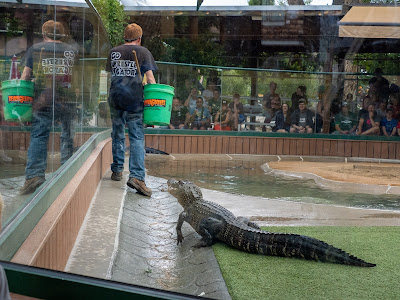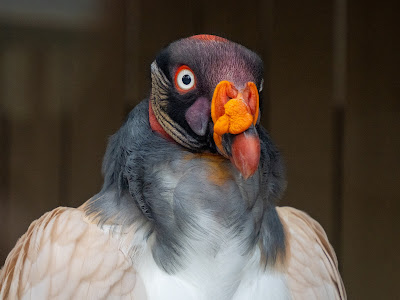It seems like each time we spend a few days in the Black Hills we discover another not-to-be-missed attraction. Some of them are obvious, like Custer State Park with its abundant wildlife and amazing rock formations and forests. Others, we have passed by for years, like last year’s discovery, Bear Country and this year's…Reptile Gardens, located between Hill City and Rapid City.
There are a number of beautiful aspects to this attraction. The obvious are the botanical gardens themselves.
They must have a whole army of gardeners to keep all the plants healthy and in bloom.
Then there are the beautiful creatures, some of them deadly. Reptile Gardens, started in 1935 as a small display of reptiles, has been listed in the Guiness Book of World Records as the largest reptile zoo in the world.
We began our visit with a show at the 'Gators and Crocs Arena.
Our host showed us how to catch an alligator, how to keep from getting bitten, and how to release the croc or 'gator you’re sitting on (You cover his eyes and look to be sure another 'gator isn't close by before you dismount.)
We also learned that, like our cows, the crocs and 'gators are bucket-trained. When thekeepver bangs his stick on the bucket, the big guys come running,
and you’d best have a piece of chicken to treat them or they may come after you!
From there, we went to the Avian Exhibit. They don’t have many birds on display, but those that were were up close and personal, and some even being hand-held.
The Yellow-billed Vulture was “sunning” with one wing outstretched. The keeper explained that not only does this activity allow the bird to regulate its body temperature, but also to air out and dry its feathers.
The Great Horned Owl and Barn Owl were happy to pose for us,
as was the Red-tailed Hawk,
And a couple of parrots and rock doves.
I think my favorite, though, was the King Vulture. A native of Central and South America, he has a wingspan of 4-7 feet and weighs 6-10 pounds. Like other vultures, he feeds on carrion. King vultures a minimally sexually dimorphic, with no difference in plumage and little in size between males and females. I think this one is a male.
A little later, the same keeper that had hosted the crocs and 'gators show gave us a short lesson on snake handling, and displayed some of the deadly and not-so-deadly residents of the zoo.
He finished off his presentation with a snake-petting session featuring an albino boa constrictor (or maybe it was a python). Any any rate, it was very popular with the kids.
It was misting rain, and the prairie dogs were all underground, so we headed for the Sky Dome,
which, along with exotic plants, snakes, frogs, toads, lizards and insects, houses the Giant Crocodile, Maniac.
At over 16 feet in length, he is one of the world’s largest saltwater crocodiles in captivity. He was acquired in 2004 from a facility in Australia. He was born in captivity in 1970, and could possibly live to be around 100 years old and 22 feet long. All the crocs and 'gators have both indoor areas and outside pens where they can go to sun or people-watch. Fortunately, Maniac was inside soaking in his pool when we visited, so we got a good look at him.
Nearby are more scary critters. The Gila monsters were well-camouflaged, as were this tarantula and a number of the snakes.
Upstairs in the Sky Dome are the many varieties of snakes from all continents.
They peered out from their glass-fronted enclosures with beady black eyes, occasionally "tasting" the air with their tongues. The one above is a species of cobra, of which I learned there are many. They are said to flare their hoods only when threatened, so we didn't see any that looked like the snake-charmer variety. And speaking of snake-charmers, it is not the snake-charmer's flute that the cobra is responding to. Snakes cannot hear or listen to music because they do not have external ears. Instead, they respond to vibrations from the ground that their bodies pick up. It is the movement of the snake charmer and his instrument that the cobra is responding to when it sways from side to side.
There also seem to be about a bazillion varieties of rattlesnake. I think this is one of them, but I'm not sure. He is well-camouflaged, though.
We saw at least a dozen different ones, most native to the American Southwest.
A native of sub-Saharan Africa, it has the longest fangs of any venomous snake...up to 2 inches in length, and the highest venom yield of any snake. They can be 4-5 feet in length, and are said to be generally unaggressive. The females can have 50-60 babies at a time, and the young are born alive.
When this remarkable fossil was discovered, Earl Brockelsby, Reptile Gardens’ founder, tried very hard to keep it in South Dakota, but was unable to generate enough interest to do so. It was eventually purchased by a museum and displayed in Vienna, Austria.
Later, after the rain let up a bit, we explored more of the gardens and visited the giant tortoise exhibit. This one was said to be 135 years old. He was napping and didn’t react at all to being petted.
His friend was almost as large, but was supposedly only 35 years old. One of the keepers explained that they actually reach their full size at about 35 years.
We enjoyed our day, and highly recommend a visit to this Black Hills attraction.

















































No comments:
Post a Comment